
Strength Training For Marathon Runners

Posted on 15 Mar, 2020

With the start of marathon training or distance running events, many guys ditch the weights in favor of additional miles on the road. While the added mileage might be beneficial for increasing endurance, it might actually lead to extra injuries. The pounding from running puts an immense strain on the body. If the muscles aren't prepared to handle the load, stress gets absorbed elsewhere including bones and connective tissue. Over time, overuse injuries including shin splints, stress fractures, and "runner's knee" can force even the most dedicated of runners to miss their target marathon.
Maintaining a strength training program is critical for improving running efficiency particularly for those going the full 26.2. "Distance running breaks down the muscles in the body and can result in a loss of strength, which in the end can slow you down," says Justin Klein, C.S.C.S., of HumanFitProject. But that doesn't mean all distance athletes are destined for failure. "With a proper strength-training program, this muscle breakdown can be assisted, and strength can be maintained through long-distance and endurance training," he adds.
While most strength-training programs will be beneficial to a point, runners should look to tailor their routine to their marathon goals. This includes adjusting their lifting schedule to mirror their running training. The two should complement each other rather than compete for time and attention. When paired together correctly, strength workouts and a running program are the perfect duo to get you through the finish line feeling strong.
Each phase of a marathon training program has a different focus. Your strength training plan should mirror and support that focus. We've outlined four typical phases of a marathon training plan allowing for a total of 16 weeks until race day and the complimentary strength training phase. Adjust your strength training according to the indicated phase to build muscle, maintain strength, and finish your marathon goal feeling strong.
PHASE 1 (WEEKS 1-4)
Marathon focus: Base
Training focus: Stability
The Base Phase of marathon training is imperative for a great performance on race day. Although the mileage and intensity may be lower, this phase is crucial to ease runners into a harder training schedule. Runners slowly begin to add miles to their training routine to increase their cardiovascular fitness and slowly acclimate their body to the increase in mileage.
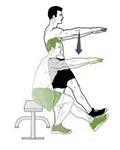 Similarly, the Stability Phase is meant to ease the body into strength training. This helps to prevent injury down the road as lifters look to increase balance, proprioception, core control, and muscle recruitment. This phase also serves as an adjustment period to introduce runners to weight training. According to Jon-Erik Kawamoto, C.S.C.S., C.E.P., of jkconditioning.com, "Runners should include strength training during the Base Phase of their marathon training so that the negative effects of weight training [delayed onset muscle soreness] does not interfere with important races."
Similarly, the Stability Phase is meant to ease the body into strength training. This helps to prevent injury down the road as lifters look to increase balance, proprioception, core control, and muscle recruitment. This phase also serves as an adjustment period to introduce runners to weight training. According to Jon-Erik Kawamoto, C.S.C.S., C.E.P., of jkconditioning.com, "Runners should include strength training during the Base Phase of their marathon training so that the negative effects of weight training [delayed onset muscle soreness] does not interfere with important races."
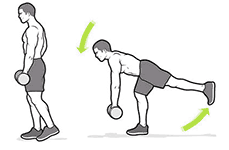 During the Stability Phase, the focus isn't on the weight but rather on form and execution. The priorities should be practicing and mastering body-weight movements including single-leg exercises like the single-leg deadlift and single-leg squat. Both exercises will strengthen the hips and prepare the muscles to handle the increased pounding on the roads. While it may be tempting to pile on the plates, keep the weight light and practice mastering the movement. Runners should focus on high-repetition sets (12-15 reps) with little rest time (30-45 seconds) in between exercises.
During the Stability Phase, the focus isn't on the weight but rather on form and execution. The priorities should be practicing and mastering body-weight movements including single-leg exercises like the single-leg deadlift and single-leg squat. Both exercises will strengthen the hips and prepare the muscles to handle the increased pounding on the roads. While it may be tempting to pile on the plates, keep the weight light and practice mastering the movement. Runners should focus on high-repetition sets (12-15 reps) with little rest time (30-45 seconds) in between exercises.
PHASE 2 (WEEKS 5-8)
Marathon focus: Aerobic Endurance
Training focus: Strength
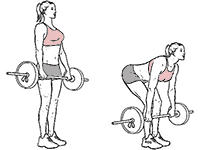 During the Aerobic Endurance Phase of marathon training, the overall mileage begins to slowly increase, and runners may choose to focus one or two days a week on faster runs. The purpose of this training phase is to slowly push the cardiovascular system and begin to prepare for harder and longer runs.
During the Aerobic Endurance Phase of marathon training, the overall mileage begins to slowly increase, and runners may choose to focus one or two days a week on faster runs. The purpose of this training phase is to slowly push the cardiovascular system and begin to prepare for harder and longer runs.
The Strength Phase in the weight room picks up where the Stability Phase left off. With the proper coordination and movement patterns in place, runners can start to add weight to exercises and work harder throughout the set. The increased intensity in the weight room helps to improve a runner's relative strength—that is their strength relative to their body weight. Since running is a body-weight sport, an increase in relative strength means less chance of injury with each footfall.
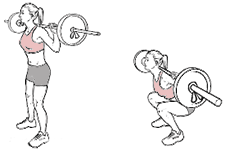 During the Strength Phase, runners should focus on bilateral exercises like the barbell squat and barbell deadlift. Whereas unilateral exercises may be the focus in the Stability Phase, it's important to choose exercises during the Strength Phase that can be loaded up to a challenging intensity. Instead of opting for higher repetitions, runners should choose a load that is challenging for five to eight repetitions. The increase in intensity also requires a longer rest period (1-2 minutes).
During the Strength Phase, runners should focus on bilateral exercises like the barbell squat and barbell deadlift. Whereas unilateral exercises may be the focus in the Stability Phase, it's important to choose exercises during the Strength Phase that can be loaded up to a challenging intensity. Instead of opting for higher repetitions, runners should choose a load that is challenging for five to eight repetitions. The increase in intensity also requires a longer rest period (1-2 minutes).
PHASE 3 (WEEKS 9-12)
Marathon focus: Peak
Training Focus: Power
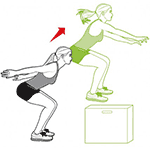 During the Peak Phase, the volume and intensity of the marathon training plan should be at its highest. Long runs may top out around 18-20 miles and additional runs during the week can leave runners pressed for time (and energy) for additional training. The entire focus now is to get the body prepared to bust through the wall at 20 miles and get to the finish line feeling strong.
During the Peak Phase, the volume and intensity of the marathon training plan should be at its highest. Long runs may top out around 18-20 miles and additional runs during the week can leave runners pressed for time (and energy) for additional training. The entire focus now is to get the body prepared to bust through the wall at 20 miles and get to the finish line feeling strong.
 Since the running volume is increased during the Peak Phase, the Power Phase in the weight room actually features a decrease in volume. This allows runners to still continue with strength training while not overloading their body with additional hours of work. With the volume in the weight room decreased, the Power Phase will focuse primarily on form and technique instead. The intensity is high since the lifts will be performed in an explosive fashion, but sets and reps are down to give runners a chance to recover.
Since the running volume is increased during the Peak Phase, the Power Phase in the weight room actually features a decrease in volume. This allows runners to still continue with strength training while not overloading their body with additional hours of work. With the volume in the weight room decreased, the Power Phase will focuse primarily on form and technique instead. The intensity is high since the lifts will be performed in an explosive fashion, but sets and reps are down to give runners a chance to recover.
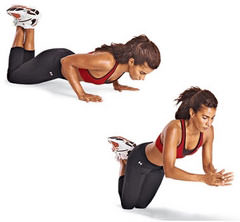 During the Power Phase, runners should stick to total-body movements and perform them quickly and explosively. Exercises like jump squats, box jumps, and plyometric pushups are perfect since they still activate muscle fibers and help you maintain strength while not putting wear and tear on the muscular system. These body-weight plyometrics can also serve another function of improving running form. "This type of training (body-weight plyometrics) will improve muscle and tendon stiffness, which has been shown in the research to improve running economy," Kawamoto says. Since the focus is on form and intensity and not volume, sets and reps should be relatively low (think 2-3 sets of 3-5 repetitions) and rest times should be fairly long (2-3 minutes) between exercises.
During the Power Phase, runners should stick to total-body movements and perform them quickly and explosively. Exercises like jump squats, box jumps, and plyometric pushups are perfect since they still activate muscle fibers and help you maintain strength while not putting wear and tear on the muscular system. These body-weight plyometrics can also serve another function of improving running form. "This type of training (body-weight plyometrics) will improve muscle and tendon stiffness, which has been shown in the research to improve running economy," Kawamoto says. Since the focus is on form and intensity and not volume, sets and reps should be relatively low (think 2-3 sets of 3-5 repetitions) and rest times should be fairly long (2-3 minutes) between exercises.
PHASE 4 (WEEKS 13-16)
Marathon focus: Taper
Training focus: Maintenance and Recovery
With the hard work in the bank, the Taper Phase of marathon training is meant to give the body some time to recover from the intense training while still maintaining a high level of fitness. Long runs are cut shorter. Additional runs during the week may be shortened as well or eliminated altogether. The entire focus is on getting runners to the line feeling strong and healthy.
To complement the Taper Phase, the Maintenance and Recovery Phase reduces the strength-training intensity as well. Runners should simply look to maintain strength and spend the rest of the time on stretching and foam rolling to promote recovery. During this phase of strength training, the focus is not on improving but rather maintaining, as the name suggests. Klein notes that this is particularly important 10 days out from your goal race. According to Klein, "Any hard training that is done within 10 days will not result in a positive outcome of a race. It's important to keep moving with some easy short runs and warmups, but rest should be the most important factor."
To promote recovery while not overstressing the muscular system, runners should shift away from heavily weighted exercises and focus more on body-weight movements like pushups, pullups, squats, and lunges. For those who still want to use additional weight, it's important to keep the load light and avoid hitting failure. During this phase, runners should go back to a higher-repetition scheme (10-15 reps) while keeping sets moderate (2-3 sets) and rest times short (45-90 seconds). Workouts during this phase should also be short to avoid overtaxing the body. The extra time can be spent with massage, ice baths, and other recovery methods designed to reduce muscle soreness and damage.
Photo Credits
Strength Conditioning For Runners


by Bart Yasso

by Peter Magill

by Matt Fitzgerald
 How To Run Downhill
How To Run Downhill Breathing Tips For Running That Could Change Your Life
Breathing Tips For Running That Could Change Your Life The Best Carbs For Runners
The Best Carbs For Runners Can You Be Vegetarian And Still Compete On A World Class Level?
Can You Be Vegetarian And Still Compete On A World Class Level?










